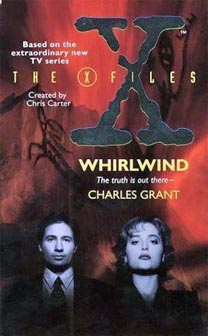Just as “The X-Files” took a couple seasons to figure out its identity, Charles Grant gets a better handle on the material in his second original novel, “Whirlwind” (1995). But while the book has fewer departures from the canon than were found in “Goblins,” it’s a weaker book overall. The New Mexico desert setting is evocative, and I can picture Mulder and Scully on this adventure, but the mystery doesn’t pop, as it’s obvious from the title what the culprit is: Mini-tornadoes that tear people to bits. (Spoilers follow.)
By revealing the “monster” right up front, “Whirlwind” isn’t much different from some “X-Files” episodes. But while the descriptions of the violence are suitably gruesome, it also gets old after the fifth or sixth time the author attempts to build suspense by describing dust devils gradually building up steam. Maybe it would’ve played better with visual effects in a TV episode, but probably not. Grant even reveals – more or less – who is behind the deadly storms right up front: Elders from an isolated Indian tribe, the Konochine.
In “Whirlwind,” Grant plays things safe with this franchise that was growing from cult hit to mainstream phenomenon. In his first book, “Goblins,” he introduced a corrupt temporary assistant director named Douglas, who plants a corrupt agent on Mulder and Scully’s team. In this book, the author abandons that thread; Skinner simply assigns this case to Mulder and Scully. Grant also resists giving the agents connections to so many characters; Mulder notes that he is slightly familiar with their law enforcement liaison, Red Garson, but that’s about it.
Continuing to make up for the imbalance in the TV series, Grant again has Scully make significant contributions to solving of the case rather than merely dogging Mulder. She doesn’t understand the science behind the whirlwinds, but she uses good cop work to conclude that the whirlwinds are indeed killing people.
The author effectively takes the reader to New Mexico in July, where the heat affects the agents’ very thought processes, and he peppers in monsoons and nighttime chilliness. The setting is reminiscent of Season 9’s “John Doe,” when Doggett wanders around Mexico, and several other episodes that take place in the Southwest.
It’s also similar to Kevin J. Anderson’s “Statues,” from the 2015 short-story collection “Trust No One.” In both yarns, a desert-dwelling artist sells works to the public through an intermediary, and in both cases, the art is the key to solving the mystery. In exploring the darker side of a Native American subculture, “Whirlwind” contrasts with the Season 2 finale (which conveniently aired around the same time as this book’s release), where Mulder finds an ally in Navajo code talker Albert Hosteen.
However, being a fan of Douglas Preston’s novels, which deliciously portray the vastness of the Southwest, I found “Whirlwind” comparatively shallow. And disappointingly, “Whirlwind’s” best mystery – how did the Konochine build dwellings on top of a mesa that has no trail or tunnels to the top? – never factors into the story.

“Whirlwind” is a cleaner story than “Goblins,” but it has fewer hooks. It can be read in a couple sittings, and it won’t dampen your enthusiasm for “The X-Files,” but you’ll quickly forget about this particular case.

